Sarah L. Johnson's Blog, page 16
July 22, 2023
Alison Weir's The King's Pleasure looks at Henry VIII's life story from his own viewpoint
 He was a ginger-haired second son, the athletic, charismatic “spare” to his overly serious elder brother. Henry VIII wasn’t born to be king, but he has come down in history as a larger-than-life monarch, known for his marriages and role in the English Reformation.
He was a ginger-haired second son, the athletic, charismatic “spare” to his overly serious elder brother. Henry VIII wasn’t born to be king, but he has come down in history as a larger-than-life monarch, known for his marriages and role in the English Reformation. In her mammoth biographical novel, royal expert Weir explores the viewpoint of this towering figure, beginning with the passing of his beloved mother, subject of her previous The Last White Rose (2022). The youth nicknamed Harry inherits a wealthy kingdom and indulges in tourneys, feasts, and luxurious clothing, evoked in detailed scenes of jaw-dropping extravagance.
In well-paced fashion, readers view his transformation from fun-loving Renaissance man consumed with his glorious image to an aging, tyrannical king desperate to ensure the succession. Weir meticulously illustrates his significant relationships, not just with his six wives but also his political allies and rivals and his shrewd advisers, like Wolsey and Cromwell.
Readers of her Six Tudor Queens series won’t find unexpected revelations here, but this believable tale is a solid choice for historical-fiction devotees.
The King's Pleasure was published in May by Ballantine, and I wrote this review for Booklist. The novel's called Henry VIII: The Heart and the Crown in the UK and is published by Headline Review. It's second in the Tudor Rose series, after The Last White Rose; a third novel, about Mary I, is forthcoming.
Doesn't the fellow on the cover resemble Prince Harry considerably? The similarities in the backgrounds of the two Harrys are clear early on, but quickly diverge once the novel gets going.
Decades ago, Norah Lofts wrote her own novel called The King's Pleasure, and its focus was Katharine of Aragon, Henry's first queen. Prolific royal chronicler Jean Plaidy also wrote a novel with this title, focused on Anne Boleyn and Catherine Howard; it was later retitled Murder Most Royal.
Published on July 22, 2023 06:27
July 15, 2023
Murder Under a Red Moon mixes family and detection in a mystery set in 1921 Bangalore
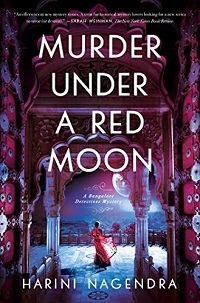 Even with a devoted husband and a police captain ally, establishing yourself as an amateur detective in 1921 South India isn’t easy when your socially conservative, grumpy mother-in-law—who resides in your home—disapproves. Fresh from her crime-solving success in the series opener,
The Bangalore Detectives Club
, Kaveri Murthy has been finding new clients and increased name recognition in Bangalore. To say she’s surprised when her athe (mother-in-law), Bhargavi, requests her help is an understatement, but Kaveri welcomes the opportunity for them to develop a stronger relationship.
Even with a devoted husband and a police captain ally, establishing yourself as an amateur detective in 1921 South India isn’t easy when your socially conservative, grumpy mother-in-law—who resides in your home—disapproves. Fresh from her crime-solving success in the series opener,
The Bangalore Detectives Club
, Kaveri Murthy has been finding new clients and increased name recognition in Bangalore. To say she’s surprised when her athe (mother-in-law), Bhargavi, requests her help is an understatement, but Kaveri welcomes the opportunity for them to develop a stronger relationship. But this new case is complicated. Bhargavi’s cousin, Mrs. Shanthi Sharma, and her husband, who own a large mill, are losing money and suspect embezzlement, potentially by their future son-in-law. Kaveri finds herself trapped in a giant family mess, and one terrible night, tensions escalate into murder.
Despite the seemingly limited list of potential killers, the plotting is even stronger in this second book. Besides her obligations to Bhargavi and the increasing danger for her personally, Kaveri has members of the Sharma household pointing fingers at each other while worrying that Bhargavi is being taken in by a charismatic swami. The presence of a particularly ugly stray dog lightens the mood, although Bhargavi thinks canines are dirty, so there’s stress there too. Kaveri has an analytical mind (and studies math in secret) but misses one clue that readers should catch onto more quickly.
The story offers abundant color, literally so, like Kaveri’s beautiful saris and the rangoli peacock design she creates on her doorstep from different hues of rice flour. Full of details on customs, tempting recipes, and social expectations for women, which Kaveri works around in her own shrewdly gentle way, this series is recommended for fans of Sujata Massey and historical mysteries in general.
Murder Under a Red Moon was published in late March by Pegasus; I wrote this review for the Historical Novels Review's May issue. The link for "rangoli" takes you out to a New York Times article showing some of the beautiful designs of this "ornate floor art."
Published on July 15, 2023 10:38
July 11, 2023
Paris, Marseille, Banyuls-sur-mer—Scenes from a Novel, a guest post by Linda Joy Myers
Linda Joy Myers, author of The Forger of Marseille, is here with an essay about her on-site research for her novel—which is published today by She Writes Press.
~
Paris, Marseille, Banyuls-sur-mer—Scenes from a NovelLinda Joy Myers
 There’s nothing like the thrill of approaching Paris on the train and seeing the Eiffel Tower rising into the sky. Finally, I’ve arrived to “research” my book in the City of Light. This is work? I chide myself as I pay the driver who stopped at my hotel in the Marais. Yes, I need to see and feel and smell Paris, and imagine it eighty years earlier. Paris is a city that speaks of history and centuries of traditions on every block, and I’m all in. Three locations are on my list to research my book The Forger of Marseille: Paris, Marseille, and a coastal village at the edge of the world, Banyuls-sur-mer, near the border of France and Spain where the shoulders of the Pyrenees rise from the sea into the sky.
There’s nothing like the thrill of approaching Paris on the train and seeing the Eiffel Tower rising into the sky. Finally, I’ve arrived to “research” my book in the City of Light. This is work? I chide myself as I pay the driver who stopped at my hotel in the Marais. Yes, I need to see and feel and smell Paris, and imagine it eighty years earlier. Paris is a city that speaks of history and centuries of traditions on every block, and I’m all in. Three locations are on my list to research my book The Forger of Marseille: Paris, Marseille, and a coastal village at the edge of the world, Banyuls-sur-mer, near the border of France and Spain where the shoulders of the Pyrenees rise from the sea into the sky.
My story is about three characters who find their way to Paris in 1938-39 as WWII ticks up toward conflagration. Cesar, a Spanish Republican, knows the gritty ways of survival having escaped over the border into France dodging machine guns wielded by Franco’s soldiers.
Sarah, a young Jewish art student and her father figure, Mr. Lieb, escaped Berlin just before Kristallnacht and feels safe in Paris. But the threat of war means they’re in danger again. In August 1939, France rounded up all “enemy aliens,” refugees who were from enemy countries, to be herded into internment camps.
Because of a chance meeting in a Paris café between Cesar and Sarah, he’s able to help them avoid that fate. Cesar knew that roundups were imminent and gave them forged identities just before war was declared. In May 1940 when the Germans threatened to occupy Paris, the three fled to Marseille located in the “Free Zone.” But nothing is free in Vichy France.
 Linda Joy Myers
Linda Joy Myers
(credit: Reenie Raschke)Through my research, I learned about the terrible danger to refugees, especially Jews, in the collaborationist Vichy government run by Phillippe Petain. And I learned there were heroes who risked their lives to save the refugees. One of those men was an American, Varian Fry. He arrived in Marseille with $3000 taped to his leg and a list in his pocket. His job was to save the crème de la crème of European intellects, artists, and writers, but once he arrived, thousands of desperate refugees lined up outside his hotel. Most were “stateless” and had no papers, in danger of arrest and internment. The underground and the rescuers were trying to save refugees, which meant they needed forgers to produce papers. The best forgers were artists who knew how to render and wield a pen.
As a fiction writer, on-site research invites me to enrich the story. I explored cobblestone back streets of the left Bank and felt the spiritual balm of the Notre Dame cathedral. Watched the sun set on the Seine. Ate baguettes and drank wine at Le Deux Magots café as an accordion played nearby.
Paris was the site of Part I of my book, then Marseille, and finally, the village of Banyuls-sur-mer. There, in the early part of the war, courageous rescuers risked their lives to guide refugees over the Pyrenees and out of France.
 St. Charles train station, Marseille
St. Charles train station, Marseille
Another thrill was arriving in the Marseille train station and looking out over the city. The Mediterranean sparkled shimmery blue beyond the Vieux Port at the bottom of the main street, the Canabiere. From my research I knew how frightening it must have been to arrive in Marseille where passport control and police were on the lookout for anyone whose papers were not in order. Even if they were able to get into Marseille, how would they escape France? Soon after France fell, all the ports were closed, but people still clung to hope that at the edge of the world in Marseille, they’d find a way to escape. The underground helped them get the necessary papers, and Varian Fry, among others, provided safe houses, money, and food. Guides would lead the refugees over the Pyrenees, and in Lisbon they’d eventually get a ship to America.
My heart beat hard as I stood on the sidewalk in front of the Hotel Splendide where Varian Fry first set up his rescue operation. A few months later he moved to offices at 62 Rue Grignon. Tears came to my eyes as I witnessed this place. I stood at the doorway where crowds of desperate refugees had begged for help.
The train to Banyuls-sur-mer follows the same route it did in 1940. With stops at Montpellier and Perpignan, I imagined how the breath caught in the throats of refugees, knowing that at any moment the police could haul them off the train. Finally, we arrived at the village, with its quiet winding one lane road that led to a safe house in the foothills. It was raining that day, and the slate was shiny, which meant the rocks climbing to the top of the Pyrenees would be slippery.
 Safe house at the foot of the Pyrenees
Safe house at the foot of the Pyrenees
I shuttered my eyelids and imagined the refugees wearing rope soled shoes, following the vignerons as they went up early in the morning to avoid being spotted by the Gestapo or the Vichy police. The wine workers would tend the vines as they had for hundreds of years, and quietly protect the refugees whose lives were being saved. I experienced a moment of reverence and gratitude that there were so many who risked their lives to save others in peril. In that same place where I stood. Witnessing history.
~
Linda Joy Myers has always been deliciously haunted by the power of the past to affect people in the stream of time. She has integrated her passion for history and her own struggles with intergenerational trauma into her work as a therapist and writer. The power of the truth to educate current generations about the past led Linda Joy to explore the little-known history of WWII in the weeks following the fall of France—which in turn led her to write The Forger of Marseille. She is the author of two memoirs, Don’t Call Me Mother and Song of the Plains, and four books on memoir writing. She’s also the founder of the National Association of Memoir Writers. You can learn more about Linda Joy’s work at www.namw.org and www.lindajoymyersauthor.com. She lives in Berkeley, CA.
~
Paris, Marseille, Banyuls-sur-mer—Scenes from a NovelLinda Joy Myers
 There’s nothing like the thrill of approaching Paris on the train and seeing the Eiffel Tower rising into the sky. Finally, I’ve arrived to “research” my book in the City of Light. This is work? I chide myself as I pay the driver who stopped at my hotel in the Marais. Yes, I need to see and feel and smell Paris, and imagine it eighty years earlier. Paris is a city that speaks of history and centuries of traditions on every block, and I’m all in. Three locations are on my list to research my book The Forger of Marseille: Paris, Marseille, and a coastal village at the edge of the world, Banyuls-sur-mer, near the border of France and Spain where the shoulders of the Pyrenees rise from the sea into the sky.
There’s nothing like the thrill of approaching Paris on the train and seeing the Eiffel Tower rising into the sky. Finally, I’ve arrived to “research” my book in the City of Light. This is work? I chide myself as I pay the driver who stopped at my hotel in the Marais. Yes, I need to see and feel and smell Paris, and imagine it eighty years earlier. Paris is a city that speaks of history and centuries of traditions on every block, and I’m all in. Three locations are on my list to research my book The Forger of Marseille: Paris, Marseille, and a coastal village at the edge of the world, Banyuls-sur-mer, near the border of France and Spain where the shoulders of the Pyrenees rise from the sea into the sky. My story is about three characters who find their way to Paris in 1938-39 as WWII ticks up toward conflagration. Cesar, a Spanish Republican, knows the gritty ways of survival having escaped over the border into France dodging machine guns wielded by Franco’s soldiers.
Sarah, a young Jewish art student and her father figure, Mr. Lieb, escaped Berlin just before Kristallnacht and feels safe in Paris. But the threat of war means they’re in danger again. In August 1939, France rounded up all “enemy aliens,” refugees who were from enemy countries, to be herded into internment camps.
Because of a chance meeting in a Paris café between Cesar and Sarah, he’s able to help them avoid that fate. Cesar knew that roundups were imminent and gave them forged identities just before war was declared. In May 1940 when the Germans threatened to occupy Paris, the three fled to Marseille located in the “Free Zone.” But nothing is free in Vichy France.
 Linda Joy Myers
Linda Joy Myers(credit: Reenie Raschke)Through my research, I learned about the terrible danger to refugees, especially Jews, in the collaborationist Vichy government run by Phillippe Petain. And I learned there were heroes who risked their lives to save the refugees. One of those men was an American, Varian Fry. He arrived in Marseille with $3000 taped to his leg and a list in his pocket. His job was to save the crème de la crème of European intellects, artists, and writers, but once he arrived, thousands of desperate refugees lined up outside his hotel. Most were “stateless” and had no papers, in danger of arrest and internment. The underground and the rescuers were trying to save refugees, which meant they needed forgers to produce papers. The best forgers were artists who knew how to render and wield a pen.
As a fiction writer, on-site research invites me to enrich the story. I explored cobblestone back streets of the left Bank and felt the spiritual balm of the Notre Dame cathedral. Watched the sun set on the Seine. Ate baguettes and drank wine at Le Deux Magots café as an accordion played nearby.
Paris was the site of Part I of my book, then Marseille, and finally, the village of Banyuls-sur-mer. There, in the early part of the war, courageous rescuers risked their lives to guide refugees over the Pyrenees and out of France.
 St. Charles train station, Marseille
St. Charles train station, MarseilleAnother thrill was arriving in the Marseille train station and looking out over the city. The Mediterranean sparkled shimmery blue beyond the Vieux Port at the bottom of the main street, the Canabiere. From my research I knew how frightening it must have been to arrive in Marseille where passport control and police were on the lookout for anyone whose papers were not in order. Even if they were able to get into Marseille, how would they escape France? Soon after France fell, all the ports were closed, but people still clung to hope that at the edge of the world in Marseille, they’d find a way to escape. The underground helped them get the necessary papers, and Varian Fry, among others, provided safe houses, money, and food. Guides would lead the refugees over the Pyrenees, and in Lisbon they’d eventually get a ship to America.
My heart beat hard as I stood on the sidewalk in front of the Hotel Splendide where Varian Fry first set up his rescue operation. A few months later he moved to offices at 62 Rue Grignon. Tears came to my eyes as I witnessed this place. I stood at the doorway where crowds of desperate refugees had begged for help.
The train to Banyuls-sur-mer follows the same route it did in 1940. With stops at Montpellier and Perpignan, I imagined how the breath caught in the throats of refugees, knowing that at any moment the police could haul them off the train. Finally, we arrived at the village, with its quiet winding one lane road that led to a safe house in the foothills. It was raining that day, and the slate was shiny, which meant the rocks climbing to the top of the Pyrenees would be slippery.
 Safe house at the foot of the Pyrenees
Safe house at the foot of the PyreneesI shuttered my eyelids and imagined the refugees wearing rope soled shoes, following the vignerons as they went up early in the morning to avoid being spotted by the Gestapo or the Vichy police. The wine workers would tend the vines as they had for hundreds of years, and quietly protect the refugees whose lives were being saved. I experienced a moment of reverence and gratitude that there were so many who risked their lives to save others in peril. In that same place where I stood. Witnessing history.
~
Linda Joy Myers has always been deliciously haunted by the power of the past to affect people in the stream of time. She has integrated her passion for history and her own struggles with intergenerational trauma into her work as a therapist and writer. The power of the truth to educate current generations about the past led Linda Joy to explore the little-known history of WWII in the weeks following the fall of France—which in turn led her to write The Forger of Marseille. She is the author of two memoirs, Don’t Call Me Mother and Song of the Plains, and four books on memoir writing. She’s also the founder of the National Association of Memoir Writers. You can learn more about Linda Joy’s work at www.namw.org and www.lindajoymyersauthor.com. She lives in Berkeley, CA.
Published on July 11, 2023 06:00
July 9, 2023
The Beasts of Paris by Stef Penney presents a wide-ranging portrait of war-torn 1870s Paris
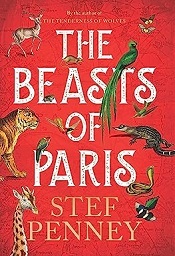 Despite its significance for the European balance of power, the Franco-Prussian War of 1870-71 is a neglected historical fiction setting. For her fourth novel, Penney illustrates its impact on Parisian residents.
Despite its significance for the European balance of power, the Franco-Prussian War of 1870-71 is a neglected historical fiction setting. For her fourth novel, Penney illustrates its impact on Parisian residents.The story itself isn’t overtly political, instead focusing on daily life amid the chaos and deprivations of war, the humiliating French defeat, and the subsequent rise and fall of the Paris Commune.
Canadian photographer Lawrence Harper works at the portrait studio of the Lamy family while wondering if an intriguing male artist returns his affection. Anne Petitjean, a half-Haitian ward girl at the Salpêtrière hospital, finds respite at the Paris zoo, where assistant veterinarian Victor Calmette cares for the menagerie. The privileged Ellis Butterfield, former U.S. Civil War surgeon, is a realistic mix of bravado and vulnerability.
Journeys of self-discovery and survival unfold alongside a heartfelt love story. Penney presents a sweeping look at Paris under siege while showing how innocents, human and animal alike, suffer during wartime. Well-rounded characters and brisk pacing are strong points in this involving tale about a volatile time.
The Beasts of Paris was published by Pegasus in the US in July 2023; I wrote this review for Booklist, and it was published in the March 1 issue. The UK publisher is Quercus.
Scottish writer Stef Penney has chosen many intriguing settings for her historical fiction, including the 19th-century Arctic for Under a Pole Star [see my review]. Her first novel The Tenderness of Wolves takes place in 1867 Canada, while The Invisible Ones is a contemporary private eye novel. In an interview for Amazon, she wrote: "I definitely do feel a pull toward people and places that are far from my own life."
She's currently writing an as-yet-untitled novel nicknamed "The Book of Nordland," which will commemorate the city of Bodø in northern Norway being named a European Capital of Culture in 2024. Residents of the county of Nordland are asked to contribute stories that could be incorporated into her writing process. Fascinating! The book is slated to be published next year, and you can read more about it on the author's website.
Published on July 09, 2023 05:42
July 2, 2023
Shelley Read's Go As a River, a poignant coming-of-age story set in wild, rustic 20th-century Colorado
 Read creates an alluring sense of place in her coming-of-age story for protagonist Victoria “Torie” Nash, whose life takes a detour after a chance meeting with a handsome boy.
Read creates an alluring sense of place in her coming-of-age story for protagonist Victoria “Torie” Nash, whose life takes a detour after a chance meeting with a handsome boy. In 1948, Torie is seventeen, a young woman who had assumed her late mother’s household chores after a tragic accident five years earlier. Her family has a farm in the ranch town of Iola in western Colorado, along the Gunnison River, where they’ve grown the region’s finest peaches for generations. I lingered over these scenes: the rocky inclines and deep valleys, the bright yellow aspens, the cool mountain air scented with sage and ripening fruit.
The downside is the human element. Prejudice against nonwhites is pervasive, and Wilson Moon, the dark-eyed drifter who becomes Torie’s rescuer and lover, is Native American. While he cares for her, Torie’s undemonstrative father keeps his distance. Her Uncle Og, disabled from his WWII injuries, is a sour presence, and her younger brother, Seth, is actively hostile.
When Torie’s romance with Wil turns heartbreaking, she’s forced into a drastic form of independence. Through much adversity and hard-won acumen, Torie finds a way to thrive economically, but her personal pain stays with her.
Despite the stunning atmosphere, some plot elements felt not-quite real to me. A small circle of stones Torie creates, in remembrance of a life-changing moment, remains undisturbed outdoors for years; some metaphors try too hard; and there are several other contrivances.
The novel’s principal truths lie in people’s relationships with the land and each other, and Torie’s realization of the courage needed for approaching life’s unknowns, which arrive “mapless and without invitation.” America’s wars play a larger role than one might expect initially, and the actual history of Iola, flooded in 1966 to build a reservoir, adds poignancy. While not completely immersive, this is an eloquent debut.
Shelley Read's Go As a River was published in March by Spiegel & Grau, and by Doubleday in the UK. It's been compared to Delia Owens' Where the Crawdads Sing for its lyrical style and focus on the main character's immersion in the natural world. The novel was based on the true history of the forgotten small town of Iola, which re-emerged into sight during a drought several years ago.
This review is cross-posted to the Historical Novel Society website. This is my 1800th blog post!
Published on July 02, 2023 05:00
June 27, 2023
The Devil's Glove, set in Maine in 1688, reveals the historical backstory to the Salem witchcraft trials
 "John Alden says that for some, fear is profit. My mother says that for many, fear is purpose. The union of the two is deadly. An unholy marriage indeed."
"John Alden says that for some, fear is profit. My mother says that for many, fear is purpose. The union of the two is deadly. An unholy marriage indeed."Back in 2002, I read Mary Beth Norton’s In the Devil’s Snare, her nonfiction book about the 1692 Salem witchcraft trials. This groundbreaking text demonstrated connections between the victims and accusers dating back to their earlier lives on the violent frontier of northern New England (now Maine).
Lucretia Grindle mines this same rich vein of research in The Devil’s Glove, first in a promised trilogy about Salem and the circumstances that led to the tragedies, a time when the Devil was said to walk in Massachusetts.
The story has a mix of fictional and real-life characters, including Captain John Alden, above (son of the Mayflower passenger of the same name). While Salem history buffs will perk up at some of the other names, I won’t spoil the details for readers who haven’t heard of them – aside from saying that the heroine, seventeen-year-old Resolve Hammond, is the author’s invention. She and her mother, Deliverance, a native of the Channel Island of Jersey, are herbalists who tend to the village women of the tiny settlement of Falmouth. They live alone, with Resolve’s father away for two years on a trading mission.
In 1688, when the local minister calls for Mistress Hammond to tend to Goodwife Hobbs, a dying woman, Resolve’s mother whispers to herself, “Why did they not use charcoal?” She quickly recognizes what others don’t – that Avis Hobbs, who is with child, was poisoned – and she wonders why the antidote wasn’t used. Unfortunately, it’s too late to save the poor woman. The Hammonds secretly suspect that Abigail Hobbs, the victim’s oddly unchildlike ten-year-old daughter, dispensed the poison, but who would believe them?
The Devil’s Glove isn’t a crime novel or a thriller, although Grindle’s previous novels fit these genres. I’d call it a historical novel with strong overtones of psychological suspense that arise naturally from the milieu. The author knows the forces that motivate people to commit dark deeds, particularly the fear that gripped the populace in this remote place. The Indians who attacked the villagers years beforehand, the French, the Catholics – all are seen as threats to the Puritan community. For this reason, Resolve and her mother, who sheltered with the sachem Ashawonks and her people during King Philip’s War, keep their knowledge, affinities, and French ancestry to themselves.
With firm roots in the complex historical politics of the region, this is an atmospheric read with a haunting sense of place and unsettling twists in the character arcs. You don’t have to be a Salem witch aficionado to read the book, but if you are, you’ll appreciate the detailed backstory to the infamous events that happened there.
The Devil's Glove was published by Casa Croce Press in May. I picked it out from NetGalley as a Read Now title.
Published on June 27, 2023 15:48
June 22, 2023
Crow Mary by Kathleen Grissom evokes the viewpoint of a heroic Indigenous woman in 19th-century North America
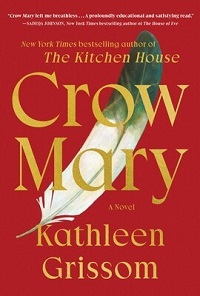 Through fiction, authors can grant little-known historical figures a deserving spotlight. Revealing the astonishing heroism of an Indigenous woman she’s wanted to write about for years, Grissom’s luminous third novel accomplishes this superbly.
Through fiction, authors can grant little-known historical figures a deserving spotlight. Revealing the astonishing heroism of an Indigenous woman she’s wanted to write about for years, Grissom’s luminous third novel accomplishes this superbly. In 1872, sixteen-year-old Goes First of the Crow people agrees to marry a “Yellow Eyes” (white) fur trader named Abe Farwell. The alliance benefits her tribe, and he needs a Native wife to help make his planned trading post successful.
The narrative delves into the trying realities of their cross-cultural marriage, which begins so promisingly. They relocate from Montana to western Canada’s Cypress Hills, where “Crow Mary” (her English name) single-handedly rescues five Nakoda women from a violent, drunken gang following a horrific massacre, an event with momentous repercussions.
Via her eloquent first-person voice, readers experience her world intimately: family life, nature’s changing seasons (early October is “the moon when the redwing blackbirds gather”), and the vast cultural differences she encounters. Through many trials and heartbreaking indignities, Goes First remains true to herself in this empathetic, indelible portrait of courage and integrity.
Crow Mary was published by Atria/Simon & Schuster on June 6th. I wrote this review for Booklist's historical fiction issue, which came out on May 15. The real Crow Mary's great-granddaughter wrote the foreword to the novel. This is Grissom's third historical novel, after The Kitchen House and Glory Over Everything.
Published on June 22, 2023 16:16
June 17, 2023
Sandra Worth's epic novel Tomorrow We Will Know presents the swan song of imperial Constantinople
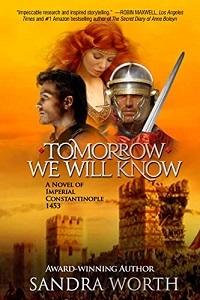 Sandra Worth has established a literary career around historical novels about real people during the Wars of the Roses and early Tudor period. Now, ten years after the publication of her last book, she pivots partly around the world with a stunningly detailed historical epic about the final years of imperial Constantinople in the mid-15th century.
Sandra Worth has established a literary career around historical novels about real people during the Wars of the Roses and early Tudor period. Now, ten years after the publication of her last book, she pivots partly around the world with a stunningly detailed historical epic about the final years of imperial Constantinople in the mid-15th century.All three of the main characters once lived, although one whose early life isn’t well documented is given a different name (you can read more in the comprehensive author’s note).
At first glance, Zoe Notaras has an illustrious life ahead: she’s the beautiful auburn-haired daughter of a high-ranking noble family in the Eastern Roman Empire, her father is immeasurably wealthy, she’s a talented musician, and she’s well-versed in literature. But she has the misfortune to be her mother’s least favorite child, for reasons she doesn’t know, and since childhood she’s had a crush on Constantine of Mistras, the emperor’s younger brother and heir, who’s destined for a marriage of state.
Constantine, over twenty years older than Zoe, has been widowed twice and bears a heavy mental load after his brother dies and he ascends the imperial throne. Though bolstered by fortified walls, Constantinople’s geographic position makes it vulnerable to attack by the Ottoman Empire; the city is also heavily reliant on outside support. Also, with his people bitterly divided about potential union with the Pope in Rome, Constantine XI finds himself in a no-win situation with a dwindling range of options.
The historical circumstances are nimbly revealed through the characters’ experiences. Although undoubtedly devoted to his country, and to Zoe – whose love he eventually returns – Constantine makes several key misjudgments and fears that a famous prophecy (implying his reign will be the empire’s last) will hold true. The arrival of a Genoese nobleman named Justiniani Longo who vows to defend Constantinople seems the answer to his prayers, but Justiniani falls in love with Zoe, complications ensue.
Worth has devoted extraordinary attention to her settings, creating a banquet for the senses on the page, from the glittering palace décor to the lemon-scented breeze along the shoreline. Zoe may seem somewhat idealized at times, but she remains easy to root for; her main fault is that she’s too trusting and romantically inclined, which leaves her unable to see flaws in others. The 53-day siege of Constantinople, which extends through much of the book’s second half, takes you step by step through the military decisions of both Constantine’s forces and those of Mehmet, the Ottoman Empire’s young and ruthless sultan – and their personal consequences.
Replete with human passions and deep-rooted courage, Tomorrow We Will Know brings readers front and center into a major turning point in history.
The novel was independently published in February; thanks to the author for the e-copy.
Published on June 17, 2023 06:00
June 11, 2023
State of the historical fiction industry: a report on this #HNS2023 conference panel
In between numerous work commitments, I’ve been spending the last week attending (virtually) the Historical Novel Society’s conference, which has been taking place in person down in San Antonio, Texas, and via Zoom. I was up bright and early on Saturday morning for the 8am State of the State: Publishing in All Its Forms panel, aka the editor/agent panel – in which four representatives from the industry responded to questions about trends and current issues in historical fiction relating to traditional publication. The panelists were Amy Durant, editorial director at Sapere Books in London; Shannon Hassan, agent at the Marsal Lyon Literary Agency; Marcy Posner, agent at Folio Literary Management; and Mitchell Waters, agent at Brandt & Hochman, all of whom work with historical novelists. The moderator was author Maryka Biaggio, HNS conference board member and editor/agent liaison.
This was a plenary session, very well-attended in person, and with around 70 virtual attendees at the highest point. While the panelists were enthusiastic about historical fiction and its potential to reach readers, the overall tone relating to the industry was sobering. Publishers are understaffed, and aside from a few chosen titles, books aren’t getting the editorial or marketing attention they used to. Agents are overworked and taking on additional tasks to get authors the support they need. Authors should get their manuscripts in as close to publishable shape as possible before submitting their work. They should also realize that they’ll need to take on many marketing activities themselves.
With all that said, let’s look in more detail at what was discussed on the panel.
Regarding trends in historical fiction: Mitchell Waters feels authors should write the book they need to write but also look around at what’s being published currently: “If you haven’t seen any books on a certain period, ask yourself why that is.” It’s hard to anticipate trends, but there are enduring themes and topics. He’s found that some editors are reluctant to go back too far in time with historicals, like before the mid-19th century. Marcy Posner said it’s hard to chase trends because they will change, and editors can be fickle; she echoed Waters’ comments that authors should write that they want and write it well. Amy Durant looks for consistently popular subjects: Tudor, medieval, Victorian, and military fiction (naval and aviation). Shannon Hassan underscored the importance of contemporary relevance for historical fiction subjects, using an example of recent novels about the Trojan War.
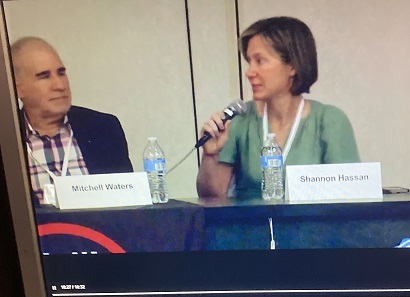
What about World War II? This question has reappeared at the last several conferences. I dare say many of the attendees were curious whether it was still hot or not. Waters admitted to feeling fatigue with the number of submissions dealing with WWII and the Holocaust, and there was a sense that some publishers were pulling back from the era, but with this topic and others, he emphasized the importance of a fresh approach: that there must be something to interest readers other than the quality of the writing.
On editing and marketing: it’s definitely the case (as mentioned by Marcy Posner) that less effort is being placed on these aspects by publishers, compared to years past. Some top books receive a great deal of attention, while others don’t; publishers are making choices about which titles to devote most of their time to. Authors and their agents must pick up the slack. Shannon Hassan said that coming to this conference gives authors a great start (my own thoughts on this: it can help them not only learn the craft but establish a network that helps them navigate the industry). Mitchell Waters noted that he has to spend less time on revisions with authors, that they need to have their books “closer to ready to go.” He cited an example where he once spent 18 months getting a manuscript ready for publication, but he can no longer do that since the volume of work has “increased exponentially.” He described a manuscript he missed out on acquiring (and which later got a good book deal), which he regrets, because he was too busy. Shannon Hassan echoed that she doesn’t have time to provide detailed feedback on queries, and it may not even be appropriate if she doesn’t fall in love with a book. Marcy Posner echoed this, saying she’s now doing the job of five people (relating to editing, marketing, counseling authors, etc.). The gist: editors and agents are swamped, something authors should keep in mind when querying.
Maryka Biaggio then asked the panelists about the issue of cultural appropriation – writing outside your own ethnicity – which generated conversation in the virtual chat room. The topic comes up frequently at HNS conferences; audience members have asked the same question of speakers at this conference, and I also remember it being asked at the in-person 2019 conference and the virtual event in 2021. The responses from industry representatives have been consistent, and I agree with the Zoom chat comment that it feels like writers (those not from the cultural group they want to write about) keep asking the question as if they’re hoping for a different response.
From Amy Durant: it’s important for writers to be sensitive to these issues, do their research, think carefully about their characters, and also question whether they’re the best person to be telling this story. Mitchell Waters tackled the issue from a marketing standpoint as well, in asking writers to consider if people will be interested in them as the author of the book, if the characters’ experiences are too far away from their own. Generally: write the best story you can, do diligent research, approach your subjects with sensitivity. For a related question dealing with depictions of LGBTQ characters in history, since there’s increased industry and reader interest in marginalized lives, Marcy Posner mentioned the importance of showing the joyful aspects of these characters’ lives, not only the struggles they face.
I didn’t make notes about the question dealing with why people might want to leave an agent, or vice versa, or the number of authors they signed from conference meetings, although the latter was a small number. Other notes from the Q&A: Waters shared some of the positive aspects of historical fiction: that people have an underlying reason to want to read it, aside from whatever beautiful writing they come across: it offers a rich canvas about a wide range of time periods (though he acknowledged some are trendier than others). The ‘60s and ‘70s are popular settings, which provides a sense of nostalgia. Advice for midlist authors: they should realize they’ll be responsible for doing additional work before submitting and after publication. He mentioned Rosamunde Pilcher’s The Shell Seekers as the author’s breakout book. She’d written many earlier novels, but The Shell Seekers was a more substantial book in many ways (in terms of scope, setting, and length – my thoughts) that allowed her to break out of the midlist. However, her situation is unusual, especially today, with publishers having less time to devote to books. Also, the phrase “fictional novel” or “fiction novel” (redundant!) looks bad in a query letter.
On prologues: These insights were especially interesting and on point. Waters mentioned they’re so frequent now because “readers have no patience” and “need to know from the first page what the stakes are.” Prologues can be a useful way of signaling to readers about events later in the plotline and can motivate readers to continue. There’s been considerable debate in the industry about whether they’re helpful. Regarding marketing strategies, Amy Durant commented that it can be hard to market an author with just a single book, so she looks for the potential for a series. (Sapere publishes many novels in series.) A question from the audience on artificial intelligence and synopses: the panelists discussed the pushback against AI (such as the model clauses for publishing contracts newly developed by the Authors’ Guild, as mentioned by Hassan). Amy Durant mentioned AI could be used as a tool for synopsis ideas, but writers should take care to write them in their own words.
So there you have it. Optimism about historical fiction, tempered with realism about the industry. The recording isn’t up yet, so this writeup is based on two pages of scribble. My fellow attendees: if I missed anything important or got anything wrong, please drop me a note or comment!
This was a plenary session, very well-attended in person, and with around 70 virtual attendees at the highest point. While the panelists were enthusiastic about historical fiction and its potential to reach readers, the overall tone relating to the industry was sobering. Publishers are understaffed, and aside from a few chosen titles, books aren’t getting the editorial or marketing attention they used to. Agents are overworked and taking on additional tasks to get authors the support they need. Authors should get their manuscripts in as close to publishable shape as possible before submitting their work. They should also realize that they’ll need to take on many marketing activities themselves.
With all that said, let’s look in more detail at what was discussed on the panel.
Regarding trends in historical fiction: Mitchell Waters feels authors should write the book they need to write but also look around at what’s being published currently: “If you haven’t seen any books on a certain period, ask yourself why that is.” It’s hard to anticipate trends, but there are enduring themes and topics. He’s found that some editors are reluctant to go back too far in time with historicals, like before the mid-19th century. Marcy Posner said it’s hard to chase trends because they will change, and editors can be fickle; she echoed Waters’ comments that authors should write that they want and write it well. Amy Durant looks for consistently popular subjects: Tudor, medieval, Victorian, and military fiction (naval and aviation). Shannon Hassan underscored the importance of contemporary relevance for historical fiction subjects, using an example of recent novels about the Trojan War.

What about World War II? This question has reappeared at the last several conferences. I dare say many of the attendees were curious whether it was still hot or not. Waters admitted to feeling fatigue with the number of submissions dealing with WWII and the Holocaust, and there was a sense that some publishers were pulling back from the era, but with this topic and others, he emphasized the importance of a fresh approach: that there must be something to interest readers other than the quality of the writing.
On editing and marketing: it’s definitely the case (as mentioned by Marcy Posner) that less effort is being placed on these aspects by publishers, compared to years past. Some top books receive a great deal of attention, while others don’t; publishers are making choices about which titles to devote most of their time to. Authors and their agents must pick up the slack. Shannon Hassan said that coming to this conference gives authors a great start (my own thoughts on this: it can help them not only learn the craft but establish a network that helps them navigate the industry). Mitchell Waters noted that he has to spend less time on revisions with authors, that they need to have their books “closer to ready to go.” He cited an example where he once spent 18 months getting a manuscript ready for publication, but he can no longer do that since the volume of work has “increased exponentially.” He described a manuscript he missed out on acquiring (and which later got a good book deal), which he regrets, because he was too busy. Shannon Hassan echoed that she doesn’t have time to provide detailed feedback on queries, and it may not even be appropriate if she doesn’t fall in love with a book. Marcy Posner echoed this, saying she’s now doing the job of five people (relating to editing, marketing, counseling authors, etc.). The gist: editors and agents are swamped, something authors should keep in mind when querying.
Maryka Biaggio then asked the panelists about the issue of cultural appropriation – writing outside your own ethnicity – which generated conversation in the virtual chat room. The topic comes up frequently at HNS conferences; audience members have asked the same question of speakers at this conference, and I also remember it being asked at the in-person 2019 conference and the virtual event in 2021. The responses from industry representatives have been consistent, and I agree with the Zoom chat comment that it feels like writers (those not from the cultural group they want to write about) keep asking the question as if they’re hoping for a different response.
From Amy Durant: it’s important for writers to be sensitive to these issues, do their research, think carefully about their characters, and also question whether they’re the best person to be telling this story. Mitchell Waters tackled the issue from a marketing standpoint as well, in asking writers to consider if people will be interested in them as the author of the book, if the characters’ experiences are too far away from their own. Generally: write the best story you can, do diligent research, approach your subjects with sensitivity. For a related question dealing with depictions of LGBTQ characters in history, since there’s increased industry and reader interest in marginalized lives, Marcy Posner mentioned the importance of showing the joyful aspects of these characters’ lives, not only the struggles they face.
I didn’t make notes about the question dealing with why people might want to leave an agent, or vice versa, or the number of authors they signed from conference meetings, although the latter was a small number. Other notes from the Q&A: Waters shared some of the positive aspects of historical fiction: that people have an underlying reason to want to read it, aside from whatever beautiful writing they come across: it offers a rich canvas about a wide range of time periods (though he acknowledged some are trendier than others). The ‘60s and ‘70s are popular settings, which provides a sense of nostalgia. Advice for midlist authors: they should realize they’ll be responsible for doing additional work before submitting and after publication. He mentioned Rosamunde Pilcher’s The Shell Seekers as the author’s breakout book. She’d written many earlier novels, but The Shell Seekers was a more substantial book in many ways (in terms of scope, setting, and length – my thoughts) that allowed her to break out of the midlist. However, her situation is unusual, especially today, with publishers having less time to devote to books. Also, the phrase “fictional novel” or “fiction novel” (redundant!) looks bad in a query letter.
On prologues: These insights were especially interesting and on point. Waters mentioned they’re so frequent now because “readers have no patience” and “need to know from the first page what the stakes are.” Prologues can be a useful way of signaling to readers about events later in the plotline and can motivate readers to continue. There’s been considerable debate in the industry about whether they’re helpful. Regarding marketing strategies, Amy Durant commented that it can be hard to market an author with just a single book, so she looks for the potential for a series. (Sapere publishes many novels in series.) A question from the audience on artificial intelligence and synopses: the panelists discussed the pushback against AI (such as the model clauses for publishing contracts newly developed by the Authors’ Guild, as mentioned by Hassan). Amy Durant mentioned AI could be used as a tool for synopsis ideas, but writers should take care to write them in their own words.
So there you have it. Optimism about historical fiction, tempered with realism about the industry. The recording isn’t up yet, so this writeup is based on two pages of scribble. My fellow attendees: if I missed anything important or got anything wrong, please drop me a note or comment!
Published on June 11, 2023 05:18
June 8, 2023
Katherine Reay's A Shadow in Moscow shows two courageous women's lives in Russia during the Cold War
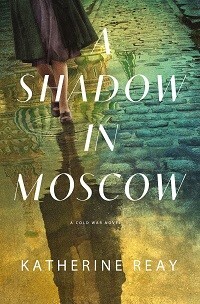 There are some historical settings most comfortably observed from a safe distance, like the pages of a novel. We can be simultaneously gripped by the characters’ world and relieved we aren’t living through the same dark, pressure-laden environment. Such is the case with Cold War Russia, where Katherine Reay’s A Shadow in Moscow takes place.
There are some historical settings most comfortably observed from a safe distance, like the pages of a novel. We can be simultaneously gripped by the characters’ world and relieved we aren’t living through the same dark, pressure-laden environment. Such is the case with Cold War Russia, where Katherine Reay’s A Shadow in Moscow takes place.The story alternates between two women in different eras, both of whom risk their lives in spying against the Soviet regime.
In 1980, Anya Kadinova is a senior at Georgetown University through her home country’s Foreign Studies Initiative, enjoying a romance with a fellow student, a spring break trip, and the freedom to read English-language novels. But her “case officer,” an upwardly mobile young man with the KGB, keeps a close eye on her movements and meets with her monthly to exchange news. After Anya returns to Moscow, she intends to emulate her parents and conform to the Soviet ideal, but when the KGB targets her good friend, she’s compelled to reach out to the CIA.
A second plotline set years earlier features Ingrid Bauer (not her real surname), a native of Vienna, who grows up in a household full of secrets she doesn’t always understand. A decade after her world was shattered during WWII, she weds Leo, a Russian man she barely knows, and settles into life in Moscow, knowing she must keep her maternal British heritage to herself. As her husband’s career expands (Ingrid suspects he’s with the KGB), their lifestyle becomes more opulent while the family’s sense of paranoia increases. No one suspects that she, a model Soviet wife and much-admired hostess and museum worker, could be passing secrets to the British.
The dialogue-heavy plotline ensures quick pacing for the story, which immerses us in the ultra-tense environment of a totalitarian regime where the state takes primacy over individual freedoms or thought. Homes and public phones are frequently bugged, and the steps the protagonists take in the “dry cleaning” process – losing any enemy agents on their trail – are elaborate and time-consuming.
Although Ingrid’s astonishing success (she comes to influence world politics at the highest level) feels far-fetched at times, the novel does demonstrate the clandestine heroism of the two women, whose roles are kept so closely guarded by their handlers that they aren’t aware of one another except by code name. The setting, within the living memory of many people today, is chilling and makes one admire the courage of anyone who dared to reach out from behind the Iron Curtain.
A Shadow in Moscow will be published by Harper Muse on June 13. This review is part of the book's online tour coordinated by Austenprose PR.
PURCHASE LINKS
AMAZON | BARNES& NOBLE | BOOKSHOP | GOODREADS | BOOKBUB
AUTHOR BIO
Katherine Reay is a national bestselling andaward-winning author who has enjoyed a lifelong affair with books. Shepublishes both fiction and nonfiction, holds a BA and MS from NorthwesternUniversity, and currently lives outside Chicago, Illinois, with her husband andthree children.
WEBSITE | TWITTER | FACEBOOK | INSTAGRAM PINTEREST | GOODREADS
Published on June 08, 2023 05:00



